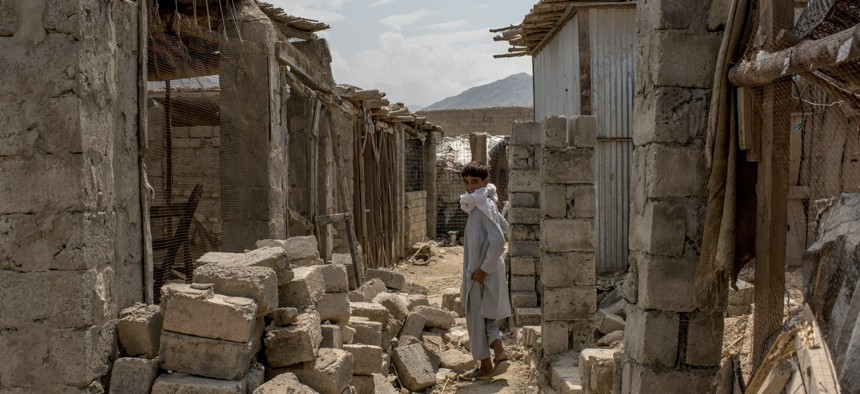
In this photo from July 2017, a boy walks through buildings damaged during fighting against the Islamic State of Iraq and Syria - Khorasan, or ISIS-K, in Nangarhar province, Afghanistan. Getty Images / Andrew Renneisen
Keep Your Eyes on Afghanistan’s ISIS-K
The Taliban’s victory was local. ISIS still wants the world.
The terrorist group that calls itself the Islamic State Khorasan Province, or ISIS-K, provided one of the last searing images of the United States’ 20-year counterterrorism mission in Afghanistan when two of its suicide bombers killed thirteen U.S. troops at Kabul’s international airport, the deadliest day for U.S. armed forces in Afghanistan since 2011.
But with that attack, ISIS also meant to demonstrate that the Taliban were unfit to protect Afghanistan. Instead, ISIS’s attack hastened the final U.S. troop withdrawal from Kabul, allowing the Taliban to finalize its fait accompli takeover of Afghanistan. Now, jihadists of all stripes are rejuvenated by the Taliban’s victory, but with one notable exception: ISIS. The group that once was able to take half of Iraq and Syria still lurks with designs against the Taliban and the world. That’s why the United States should not discount ISIS-K’s threat in Afghanistan and beyond.
The Islamic State needed Afghanistan’s chaos. It has not regrouped since the death of its leader Abu Bakr al-Baghdadi in 2019 and the loss of its territorial caliphate in Syria and Iraq. Al-Qaeda also has been a shell of its former self, even long before U.S. troops killed Osama bin Laden. In fact, terrorist attacks worldwide in 2020 markedly decreased. And in Afghanistan, ISIS-K was competing directly with al-Qaeda for dwindling fighters and funding there, amid thousands of U.S. and NATO troops. The Taliban’s victory provides air to jihadists who have been suffocating, strangled by the world’s counterterrorism initiatives—but which organizations will most benefit?
Before Sept. 11, 2001, the Taliban provided al-Qaeda sanctuary and the groups remain bonded. Al-Qaeda hasn’t given up on striking what it has called the “far-enemy”, the United States and its allies. Taliban control over Afghanistan will provide al-Qaeda the ability to heal, lick its wounds, and plan. Afghanistan will become a safe haven that will allow al-Qaeda to amass new recruits, raise finance, and plan external operations. The al-Qaeda resurgence will likely take time, but researchers report that foreign fighters are relocating to Afghanistan, on top of the approximately 10,000 foreign terrorist fighters already there, according to a United Nations report in June. That number, in my estimation, will rise significantly and when it does Afghanistan will become a playground for those fighters, not unlike what the world witnessed when ISIS peaked in Iraq and Syria.
ISIS-K stands to benefit from the flow of foreign fighters, but not to the extent of al-Qaeda, which is now aligned with the ruling Taliban. Recall ISIS-K was formed in 2014 from disaffected members of the Afghan Taliban, Pakistan Taliban, the Islamic Movement of Uzbekistan, amongst other groups. ISIS-K became a “province” of ISIS in 2015 when al-Baghdadi accepted an oath of allegiance from ISIS-K’s leadership. Not long after, my old office at the State Department led the effort to declare ISIS-K a designated Foreign Terrorist Organization.
Like its parent, ISIS-K quickly became known for its indiscriminate brutality, attacking religious minorities, government officials, and those who resisted the group’s austere form of Islam. Totalitarian in nature, ISIS-K members would kill anybody that would not accede to the group’s desire to control all aspects of an individual’s social, political, and religious life. As ISIS-K’s followers slaughtered innocents from 2016-2020, they would use complex attacks, often combining suicide bombings and small-arms, to wreak havoc. In 2020, ISIS-K attacked a maternity ward in a Shiite neighborhood of Kabul, killing more than 20 women and newborns.
ISIS-K also believes that al-Qaeda and the Taliban are too locally focused and disinterested in establishing a global caliphate. In 2015, Al-Qaeda’s former leader Ayman al-Zawahiri chastised ISIS’s al-Baghdadi for anointing himself caliph of the self-declared Islamic State. Al-Qaeda was always opposed to creating a global caliphate too quickly, citing the need to govern successfully by tending to the masses. ISIS instead bet on its ability to metastasize globally and for a time eclipsed the already-diminished al-Qaeda within jihadist circles. In Afghanistan, though, al-Qaeda’s leaders have pledged their allegiance to the Taliban.
With the U.S. evacuation of all diplomatic and military personnel, and most U.S. civilians, from Afghanistan, Americans should resist the inclination to ignore the battle between the Taliban, al-Qaeda, ISIS-K triumvirate of terror. The threat posed to U.S. interests by ISIS-K outside of the Af/Pak region has been discounted long enough. Most recently, event Trump administration officials dismissed ISIS-K as a threat. While I agree that al-Qaeda represents a more significant threat to U.S. interests, I disagree with experts who disregard ISIS-K as a threat beyond the contours of Central and South Asia. Theirs is a failure of imagination.
I still recall vividly a failed terrorist attack in Times Square by Faisal Shahzad in 2010. Shahzad received training and financial sponsorship from the Pakistan Taliban, a group that many in government believed, including me, was inwardly focused. In 2014, ISIS-K would poach members from that same group. Later, in 2016 and in 2018, U.S. citizens attempted to provide material support to ISIS-K. They are examples of ISIS-K’s reach far beyond Afghanistan and Pakistan.
Jason M. Blazakis is a professor of practice at the Middlebury Institute of International Studies and a senior research fellow at the Soufan Center. Between 2008-2018 he was the office director at the State Department’s Counterterrorism Bureau, responsible for designating Foreign Terrorist Organizations.
NEXT STORY: How China Is Planning For a Tech Decoupling
